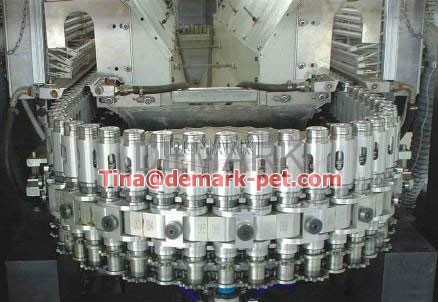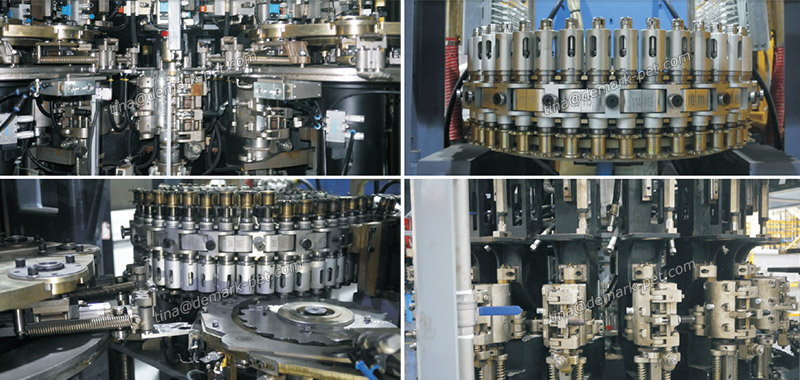Linear or Rotary… That is a Question!
Linear blow molding machine or Rotary blow moulding machine, what should I choose, that is a big question! Now, Tina will tell you the same and the difference of these two type. The same is they accept injection molded preforms, reheat them in an oven system with preforms spinning on mandrels or spigots, then bring them into blow molds to be stretched and blown. In the end, upright containers leave on a conveyor.

Rotary Blowing Machine Process
Rotary blowing mold machine features the concept of continuous motion. Many functions on the machine are driven by cams. The preforms never stop on their way from the entrance to the exit conveyor. Each preform is blown in a single blow mold with its own stretch rod and set of blow valves.
Linear blow molding machines often index the preforms when they travel through the oven system: 2, 4, 6, or 8 preforms are all loaded, then index one position, stop, index again and so on… Once they leave the oven section the same number of preforms was loaded at the beginning, and enters the blow molding clamp area together. All blow molds are on the same platen and move together. Numbers of stretch rods and blow valves usually are tied together, all move or open at the same time. Some machines be equipped with more controlls in this area by allowing certain functions to be energized seperately. After blowing, all bottles are sent to a stand-up conveyor.

Linear Blow Molding Machine Process
Different supplier, different machines. They may be as subtle as what mechanism (timer or position switch or both) is used to strengthen the low and high pressure blow air. They may be more substantial in whether clamp and stretch rod are powered by cams, hydraulics, pneumatics, or electrics. Here I will not discuss these field in great details because those do not change the basic process. They are often related to operational efficiency and the amount of main cost (rotary machines from the same supplier are often the double price of linear machines for the same cavity). this article is about how the different organization of preform control affects the blowing process, the quality and consistency of bottles. There is a feature that I want to explore a bit and it is the way the preform is oriented as it pass the oven. Most linear blow molding machine runs preforms through the ovens and blow preforms upside down. It usually to make the preforms upside-down that are right side up coming from the unscrambler, then flipping them again after blowing. These flipping stations are probably the most part to be maintenance on the machine because they usually feature 4 pneumatic cylinders, more or less flimsily arranged and easy to mis-feeds, jam-ups, and breakage.
Rotary machines have much better in in-feed and out-feed systems. The mandrels used are also more elaborate to hold the preforms better. When it comes to preform locating there are three systems in place:
In the Demark system, preforms are heated upside down, then turned and blown right side up (exception their linear machine).For SIG system, preforms are heated and blown upside down and the bottles turned right side up.
It has two sides for either system. Heating the preform upside down makes it easier to protect the neck finish not to be heated. It can be important as neck finishes get bigger and the hoop stress on the neck increases exponentially. When PET gets warmer it also becomes softer and easier to blow an oval neck. But, if adequate air flow is provided in the oven system and especially if necks stay 33 mm or below there are a great many advantages not having to turn preforms or bottles. Every turn carries the chance of wear and complications and it may indicate how successful the Krones system is that the linear Demark machines also do not turn preforms or bottles and other manufacturers have followed suit.

Now come back to the basic process the difference between linear and rotary machines. To jump right into the middle of things, let me make one statement: Indexing machines cannot reheat all preforms of one set (be it 2, 4, or more) to the same temperature in any spot because of wall thickness distribution differences in the bottles thus produced. The reason for this has two parts:
Heat lamps in the ovens are not at the same temperature over the length of the lamp. I have measured several times and found the center sections to be about 60º C hotter than the end parts. When preforms index through the oven system, not every preform spends the exact amount of time in front of the hot and cooler sections. It would be virtually impossible to build a system where this was the case. Instead, you may find that the two outer preforms in a 4-cavity machine are warmer or colder than the two inside ones. Or it may be preform #1 and 3 share the same temperature, so do preforms #2 and 4 blowing mould. No matter how much they are in difference and which preforms have which temperature, they are never the same.
Adding to this discrepancy is the fact that preforms that come to have a rest at the beginning or end of an oven section after indexing, when there is no oven directly behind it (such as around the corners) may or may not get some of the heat the emanates from the oven. Again, some preforms get more of this than others.
What does this temperature influence on your bottles? You will always see a difference, but on some bottles this difference is so small that it may be overlooked and has no impact on the overall quality. However, there are other bottles, some with oblong shapes or at the lower end of the weight scale, it will make big difference.

Somewhere in between the optimal rotary and the indexing system is a combination that is fast becoming the standard for linear machines. Adopted so far by Demark Machinery in this system preforms move continuously through the oven system, usually at a small degree. At the end of it they are taken by grippers, spread into the right center distance for the blow mold, and then taken out there. This is a good compromise and even tough there are still small temperature differences between the first and last preform out of the oven, these are relatively small and can usually be tolerated.
Converters and brand owners ask for a high degree of flexibility as well as low cost from blow molding manufacturers. Linear machines can satisfied both. Continuous motion through the ovens helps achieve consistency, it is close to rotary machines. However, only rotary machines can produce completely identical preforms and bottles.
You may also like:
Notice: The views expressed are my own and do not necessarily represent the views of DEMARK.
Copyright © 2013 - 2024 www.pet-machinery.com all rights reserved. Designed by Tina | Sitemap
